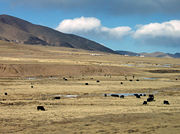Animal husbandry
| Agriculture | ||
|---|---|---|
 |
||
| General | ||
| Agribusiness · Agriculture Agricultural science · Agronomy |
||
| History | ||
| History of agriculture Neolithic Revolution |
||
| Particular | ||
| Aquaculture · Christmas trees · Dairy farming Grazing · Hydroponics · IMTA |
||
| Categories | ||
| Agriculture by country Agriculture companies |
||
|
Animal husbandry, also called animal science, stockbreeding or simple husbandry, is the agricultural practice of breeding and raising livestock. It has been practiced for thousands of years, since the first domestication of animals.
The science of animal husbandry is taught in many universities and colleges around the world. Students of animal science may pursue degrees in veterinary medicine following graduation, or go on to pursue master's degrees or doctorates in disciplines such as nutrition, genetics and animal breeding, or reproductive physiology. Graduates of these programs may be found working in the veterinary and human pharmaceutical industries, the livestock and pet supply and feed industries, farming or in academia.
Historically, certain sub-professions within the field of animal husbandry are specifically named according to the animals that are cared for.
Contents |
Different types of animal husbandry
A swineherd is a person who cares for hogs and pigs (older English term: swine). A shepherd is a person who cares for sheep. A goatherd cares for goats. A cowherd cares for cattle. In previous years, it was common to have herds which were made up of sheep and goats. In his case, the person tending them was called a shepherd. Camels are also cared for in herds. In Tibet yaks are herded. In Latin America, llamas and alpacas are herded.
In more modern times, the cowboys or vaqueros of North and South America ride horses and participate in cattle drives to watch over cows and bulls raised primarily for food. In Australia many herds are managed by farmers on motorbikes and in helicopters. Today, herd managers often oversee thousands of animals and many staff. Farms and ranches may employ breeders, herd health specialists, feeders, and milkers to help care for the animals. Techniques such as artificial insemination and embryo transfer are frequently used, not only as methods to guarantee that females are bred, but to help improve herd genetics. This may be done by transplanting embryos from stud-quality females, into flock-quality surrogate mothers - freeing up the stud-quality mother to be reimpregnated. This practice vastly increases the number of offspring which may be produced by a small selection of stud-quality parent animals. This in turn improves the ability of the animals to convert feed to meat, milk, or fiber more efficiently and improve the quality of the final product.
Ethical aspects of animal husbandry

There are contrasting views on the ethical aspects of breeding animals in captivity, with one debate being in relation to the merits of allowing animals to live in natural conditions which are reasonably close to those of their wild ancestors, compared to the view that considers natural pressures and stresses upon wild animals from disease, predation, and the like as vindication for captive breeding.
Some techniques of animal husbandry such as factory farming, tail docking, the Geier Hitch, and castration, have been condemned by animal welfare activists and groups such as Compassion In World Farming. Genetic engineering is also controversial though it does not necessarily involve suffering. Animal rights activists are often opposed to all forms of animal husbandry.
Some domesticated species of animals, such as the vechur cow, are rare breeds and are endangered. They are the subject of conservation efforts.


See also
- Domestication of animals
- Animal keeping
- Aquaculture
- Beekeeping
- Breeder
- Breeding in the wild
- Cattle
- Cuniculture
- Dog breeding
- Environmental effects of meat production
- Feed conversion rate
- Food industry
- Horse breeding
- Herpetoculture
- Poultry
- Pastoral nomads
- Sheep husbandry
- Shepherding
- Stockman
- Transhumance
- Block & Bridle
Sources and notes
- Saltini Antonio, Storia delle scienze agrarie, 4 vols, Bologna 1984-89, ISBN 88-206-2412-5, ISBN 88-206-2413-3, ISBN 88-206-2414-1, ISBN 88-206-2414-X
- Clutton Brock Juliet, The walking larder. Patterns of domestication, pastoralism and predation, Unwin Hyman, London 1988
- Clutton Brock Juliet, Horse power: a history of the horse and donkey in human societies, National history Museum publications, London 1992
- Fleming G., Guzzoni M., Storia cronologica delle epizoozie dal 1409 av. Cristo sino al 1800, in Gazzetta medico-veterinaria, I-II, Milano 1871-72
- Hall S, Clutton Brock Juliet, Two hundred years of British farm livestock, Natural History Museum Publications, London 1988
- Janick Jules, Noller Carl H., Rhykerd Charles L., The Cycles of Plant and Animal Nutrition, in Food and Agriculture, Scientific American Books, San Francisco 1976
- Manger Louis N., A History of the Life Sciences, M. Dekker, New York, Basel 2002
External links
- Research Institute for Animal Husbandry
- Institute of Genetics and Animal Breeding PAS
- Food and Agriculture Organization of the United Nations (FAO)
- In situ conservation of livestock and poultry, 1992, Online book, Food and Agriculture Organization of the United Nations and the United Nations Environment Programme
- Dr. Temple Grandin's Web Page Livestock Behaviour, Design of Facilities and Humane Slaughter
